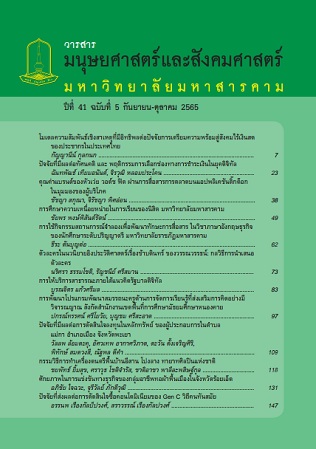Causal Relationship Model of the Influence to Preparation towards the Cashless Society in Thailand
Main Article Content
Abstract
The objectives of this research study are: to creating a model for a preparation towards the cashless society in Thailand; to study the influencing causal factors of a preparation towards the cashless society in Thailand; and to guide in technology and financial innovation development towards the cashless society.
This research study applied a quantitative method using questionnaires that focused on 660 people have been the making financial transactions through internet. The statistical treatment of this study was based on statistical techniques such as Structural Equation Modeling (SEM), frequency, percentage, means, and standard deviation.
The results show that the model is consistent with empirical data: X2 / df = 2.376 RMSEA = 0.046 GFI = 0.93 CFI = 0.97 AGFI = 0.91 IFI = 0.97 TLI = 0.96 RMR = 0.026 and SRMR = 0.035. Furthermore, the path analysis results show that factors of acceptance have a direct and effect on a preparation towards the cashless society in Thailand. Furthermore, the factors of media exposure motivation and satisfaction have indirect and effect on a preparation towards the cashless society in Thailand. At a significance level of 0.001. In conclusion, dominant implications of the findings are indicated for a preparation towards the cashless society in Thailand. And preparation towards the cashless society to guide in technology and financial innovation development towards the cashless society in the future.
Article Details
References
Balakrishnan V., & MohdShuib N. L. (2021). Drivers and inhibitors for digital payment adoption using the Cashless Society Readiness - Adoption model in Malaysia. Technology in Society, 65. Available from:URL// www.sciencedirect.com/science/article/pii/S0160791X21000294
Bastari A., Eliyana A., Syabarrudin A., Arief Z., & Emur A.P. (2020). Digitalization in banking sector: the role of intrinsic motivation. International Journal of Heliyon, 6(12). Available from:URL// www.doi.org/10.1016/j.heliyon.2020.e05801
Boonmeesuwan C. (2018). Cashless Society. Business Review, 10 (1). 235 - 284. Available from:URL// www.file:///C:/Users/WIN7RSU/Downloads/162341-Article%20Text-449838-1-10-20181224.pdf
Bounie D., Camara Y., & Galbraith J. W. (2020). Card-sales response to merchant contactless payment acceptance. Journal of Banking & Finance, 119. Available from:URL// www.doi.org/10.1016/j.jbankfin.2020.105938
Bounie D., Camara Y., & Galbraith J. W. (2020). Consumers' Mobility, Expenditure and Online-Offline Substitution Response to COVID-19: Evidence from French Transaction Data. Journal of Economic Literature classification: E21, E62, E61. Available from:URL// www.papers.ssrn.com/sol3/papers.cfm?abstract_id=3588373
Daragmeh A., Lentner C., & Sági J. (2021). FinTech payments in the era of COVID-19: Factors influencing behavioral intentions of “Generation X” in Hungary to use mobile payment. Journal of Behavioral and Experimental Finance, 32. Available from:URL// www.sciencedirect.com/science/article/pii/S2214635021001180
Digital Government Development Agency. (2021). Digital Government Technology and Innovation. Available from:URL// www.dgti.dga.or.th/
Fedorowiczab J., Gelinas U. J., Gogan J. L., & Williams C. B. (2009). Strategic alignment of participant motivations in e-government collaborations: The Internet Payment Platform pilot. International Journal of government information quarterly, 26 (1), 51 - 59. Available from:URL// www.doi.org/10.1016/j.giq.2008.03.004
Fornell C., & Larcker D. F. (1981). Evaluating structural equation models with unobservable variables and measurement error. Journal of Marketing Research, 18(1), 39–50.
Geebren A., Jabbar A., & Luo M. (2021). Examining the role of consumer satisfaction within mobile eco-systems: Evidence from mobile banking services. Computers in Human Behavior, 114. Available from:URL// www.doi.org/10.1016/j.chb.2020.106584
Hair J., Black W., & Babin B. (2014). Multivariable data analysis. 7th.
Lertwisettheeraku S., Rassameethes B., & Sangmahacha K. (2019). Factors Affecting Readiness to Cashless Society of People in Bangkok. The 57th Kasetsart University Annual Conference. 285-294 Available from:URL// www.file:///C:/Users/WIN7RSU/Downloads/KC5715003%20(2).pdf
MasrekaIntan M. N., Mohamed I. S., Daud N. M., Omar N. (2014). Technology Trust and Mobile Banking Satisfaction: A Case of Malaysian Consumers. Procedia - Social and Behavioral Sciences, 129, 53-58. Available from:URL// www.doi.org/10.1016/j.sbspro.2014.03.647
Rangsungnoen G. (2011). Factor analysis with SPSS and AMOS for research. Bangkok: SE-Education.
Schierz P. G., Schilke O., & Wirtz B. W. (2010). Understanding consumer acceptance of mobile payment services: An empirical analysis. Electronic Commerce Research and Applications, 9(3), 209 - 216. Available from:URL// www.doi.org/10.1016/j.elerap.2009.07.005
Sirimahasuwat T., & Worakullattanee K. (2017). Media Exposure, Adoption of Innovation Factors and Behavior of Consumer Using or Payment. Thesis Faculty of Journalism and Mass Communication Thammasat University. Available from:URL// www.ethesisarchive.library.tu.ac.th/thesis/2017/TU_2017_5907011018_8128_8366.pdf.
Sisaard B. (2013). Basic research (9th ed). Bangkok: Suweeriyasan.
Sukato A. (2021). Cashless Society. Bangkok: National Assembly Library of Thailand. Available from:URL// www.library.parliament.go.th/th/radioscript-rr2564-may5
Swiecka B., Terefenko P., Wisniewski T., & Xiao J. (2021). Consumer Financial Knowledge and Cashless Payment Behavior for Sustainable Development in Poland. Economic and Business Aspects of Sustainability 13(11). Available from:URL// www.doi.org/10.3390/su13116401
Teerakasemsuk P., & Punyapiroje C. (2015). Media Exposure, Attitudes and Avoidance Behaviors in Mobile Application Advertising of Thai Teenagers. Advisory Committee. A Thesis Master of Arts Program in Faculty of Humanities and Social Science Burapha University.
Thammavanich T. (2020). Attitude and Preparation of Cashless Society of Nakhon Si Thammarat People. Available from:URL// www.ba-abstract.ru.ac.th/index.php/abstractData/viewIndex/212.ru
Verkijika S. F. (2020). An effective response model for understanding the acceptance of mobile payment systems. Electronic Commerce Research and Applications, 39. Available from:URL// www.doi.org/10.1016/j.elerap.2019.100905
Yeo G. M. L., Lim S. F., Tan K. B., & Huat S. (2016). Understanding Customer Satisfaction of Internet Banking: A Case Study in Malacca. International Journal of Procedia Economics and Finance, 37, 80 - 85. Available from:URL// www.doi.org/10.1016/S2212-5671(16)30096-X
Zhong Y., Oh S., & Moon H. C. (2021). Service transformation under industry 4.0: Investigating acceptance of facial recognition payment through an extended technology acceptance model. Technology in Society, 64. Available from:URL// www.doi.org/10.1016/j.techsoc.2020.101515

